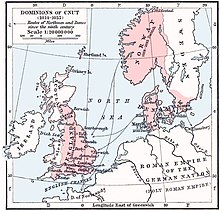


The terms Danish March and March of Schleswig (‹See Tfd›German: Dänische Mark or Mark Schleswig) are used to refer to a territory in modern-day Schleswig-Holstein north of the Eider and south of the Danevirke. It was established in the Early Middle Ages as a March of the Frankish Empire to defend against the Danes. The term "Danish March" is a modern designation not found in mediaeval sources. According to the Royal Frankish Annals, the Danish King led his troops "into the March" in 828 (ad marcam). In the 852 Yearbook of Fulda, there is mention of a "Guardian of the Danish Border" (custodes Danici limitis).
In Old Norse, Denmark was called Danmǫrk, viz. the marches of the Danes. The Latin name is Dania.